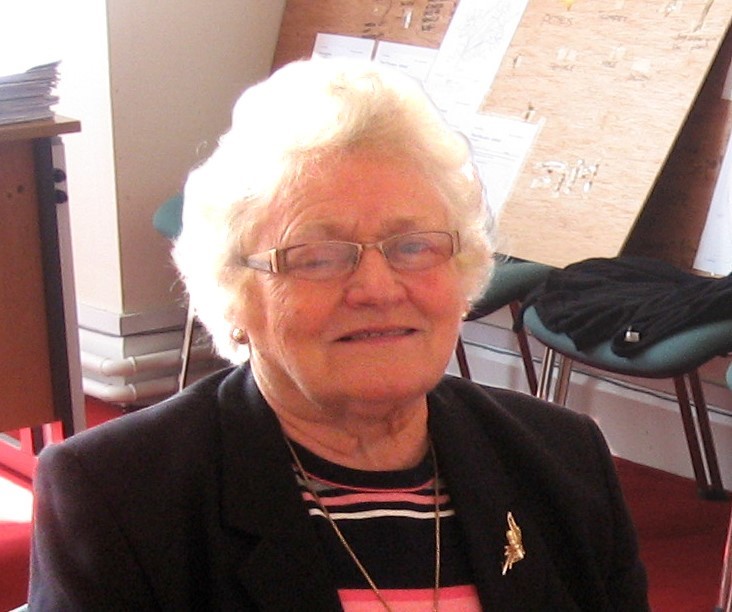Eileen Jones: Blackpool, Shawlies, Sunbeam,
Title
Subject
Description
There was no secondary school in Blackpool, but some students could stay on in primary school. She left at 14. She praised a teacher, Miss Hourigan, who gave the class a love of the ritual of the mass, and of basic maths and arithmetic, which stood to them in later life.
Eileen worked in the Sunbeam factory, and in Cork Spinning Company. She later got a job in Roches Stores, and she tells the story of how she came to get chosen for the job.
She talks in detail about the neighbourhood of Welsh’s Lane; how visiting strangers were quizzed. Children played out all day, their meals served according to the time kept by a local factory siren.
She recalls some of the words of the rhymes they sang while skipping. She lists the names of the lanes she knew in her youth.
Mentions that Kilcully graveyard had a lot of Traveller graves [Interviewee calls the Travellers ‘gypsies’]
She remembers the names of local shops; and The Co-Op where you earned stamps to exchange for goods.
She talks about a savings bank in St Mary’s Hall; it was a shilling to join.
Eileen remembers the clothes women wore before the war: shawls, kitchen aprons, petticoats. Her grandmother wore a black shawl; Traveller women wore fawn and brown plaid shawls. She tells a story about a woman who collected shawls from the deceased when they were laid out.
When she was born she was not expected to live and was taken close care of. She tells the story of her being christened with a name chosen by the priest.
She worked in the Sunbeam factory. Her supervisor lead prayers during the day. She didn’t like the portrayal of the workers in “The Sunbeam Girls”. The women workers sang as they worked.
Eileen also recalls bonfire night, drinking ‘razza’ and listening to people singing. Workers could go for baths in the Sunbeam factory; few people had baths in their houses.
Date
Identifier
Coverage
Relation
CFP_SR00387_sheehan_2010; CFP_SR00388_sheehan_2010; CFP_SR00389_healy_2010; CFP_SR00390_kelleher_2010; CFP_SR00391_crean_2010; CFP_SR00392_mckeon_2010; CFP_SR00393_twomey_2010; CFP_SR00394_stleger_2010; CFP_SR00395_speight_2010; CFP_SR00396_lane_2010; CFP_SR00397_obrienoleary_2010;
CFP_SR00399_saville_2010; CFP_SR00400_magnier_2010; CFP_SR00401_marshall_2010; CFP_SR00402_marshall_2010; CFP_SR00403_murphy_2010; CFP_SR00404_prout_2011; CFP_SR00405_walsh_2011; CFP_SR00406_prout_2011; CFP_SR00407_newman_2010; CFP_SR00408_newman_2010; CFP_SR00409_leahy_2011; CFP_SR00411_newman_2010; CFP_SR00412_newman_2010; CFP_SR00413_finn_2011; CFP_SR00414_ohorgain_2011; CFP_SR00415_oconnell_2011; CFP_SR00416_sheehy_2011; CFP_SR00417_mcloughlin_2012; CFP_SR00418_gerety_2012; CFP_SR00419_kelleher_2012; CFP_SR00420_byrne_2012; CFP_SR00421_cronin_2012; CFP_SR00422_ohuigin_2012; CFP_SR00423_meacle_2012; CFP_SR00424_horgan_2012; CFP_SR00425_lyons_2012; CFP_SR00427_goulding_2011;
CFP_SR00491_fitzgerald_2013.
Heritage Week 2011: CFP_SR00429_casey_2011; CFP_SR00430_tomas_2011; CFP_SR00431_newman_2011; CFP_SR00432_stillwell_2011; CFP_SR00433_oconnell_2011; CFP_SR00434_lane_2011; CFP_SR00435_montgomery-mcconville_2011; CFP_SR00436_ocallaghan_2011; CFP_SR00437_corcoran_2011; CFP_SR00438_jones_2011; CFP_SR00439_ohuigin_2011; CFP_SR00440_mccarthy_2011; CFP_SR00441_crowley_2011; CFP_SR00442_obrien_2011; CFP_SR00443_jones_2011; CFP_SR00444_mcgillicuddy_2011; CFP_SR00445_delay_2011; CFP_SR00446_murphy_2011;
Video Interview: CFP_VR00486_speight_2014
Published Material:
O’Carroll, Clíona (2011) ‘The Cork Memory Map’, Béascna 7: 184-188.
O’Carroll, Clíona (2012) ‘Cork Memory Map: an update on CFP’s Online Project’, The Archive 16: 14. https://www.ucc.ie/en/media/research/corkfolkloreproject/archivepdfs/archive16.PDF
Dee, Stephen and O’Carroll, Clíona (2012) ‘Sound Excerpts: Interviews from Heritage Week’, The Archive 16: 15-17. https://www.ucc.ie/en/media/research/corkfolkloreproject/archivepdfs/archive16.PDF
O'Carrol, Clíona (2014) 'The children's perspectives: Place-centred interviewing and multiple diversified livelihood strategies in Cork city, 1935-1960'. Béaloideas - The Journal of Folklore of Ireland Society, 82: 45-65.
The Curious Ear/Documentary on One (Cork City Memory Map) http://www.rte.ie/radio1/doconone/2011/0816/646858-curious-ear-doconone-cork-city-memory-map/
Source
Rights
Language
Type
Format
Interviewee
Interviewer
Duration
Location
Original Format
Bit Rate/Frequency
Transcription
E J: The Thirties. Now I was born in ’31 and we’ll say that was all through the thirties now. The war started in ’39 and things were very bad, we were very poor like, but we didn’t know it. I mean in relative to today now we were very poor but ya see everybody was the same, so you didn’t realise you were poor. ’Tis only if you -- by comparison, that you realise you’re poor. If everybody is the same it doesn’t make any difference ya see. But the war came then and shortages like I mean, the rationing and everything and I was only thinking there now last week something struck me. Em, I love, I’d love now a heel of bread, a crusty heel of a skull and put loads of butter on it. And I did that last week and I was there on me own and I had a grand crusty heel and I was -- and I just thought, I remember, going back now, I’m going back to the time of the war. We had only an ounce, two ounces of butter or something that’s all you’d get. And I loved butter and I hated margarine. Couldn’t oh, I couldn’t stick the taste of the margarine. My mother used to scrape the margarine on the bread the way that I wouldn’t get the taste of it but I could taste it like. And em, I remember one time she was so mad at me now giving out about the margarine she gave me me own two ounces of butter for to manage meself for the week. Ya see she cut a bit of butter and she gave it to me on the small plate and she said, ‘There now,’ she said. ‘Eat that now or you can, you can eat it all today but you’ll have nothing for the week.’ And I got the butter anyway and I was being very careful and next thing now like that I got a heel and I decided put it, what I had left on top of the heel. And I sat down and ate it and me mother totally told my father and all when he came in from work, ‘Never believe what she’s after doing. The only bit of butter she have left for the week she’s after eating it on a crust of bread.’ So that was like, but I enjoyed it and I loved it d’ya know now what I? Now I didn’t do it anymore because I found having margarine for the rest of the week wasn’t great like but I enjoyed it. But isn’t it funny how things would remind ya? Last week now that reminded me of -- you know?

